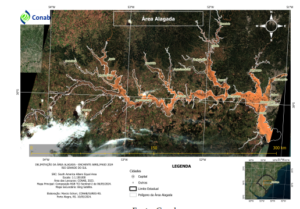The floods in Rio Grande do Sul and the impact on agricultural production
See how the floods in RS affected the production of the main local agricultural products: soybeans, wheat, corn and rice.
The heavy rains in Rio Grande do Sul began on April 27, 2024 and intensified from April 29 onwards, with ten days of high rainfall. Almost the entire state was heavily affected, but the worst-hit areas were the valleys of the Taquari, Caí, Pardo, Jacuí, Sinos and Gravataí rivers. Overloaded, these rivers flooded the Guaíba in Porto Alegre and the Lagoa dos Patos in Pelotas and Rio Grande, causing further flooding in these regions.
In addition to the humanitarian impacts caused by this climatic event, the state’s economy was directly affected, with significant damage to companies, businesses and local agriculture.
In this article, we analyze the post-rainfall figures that show the real scale and impact of the floods in Rio Grande do Sul on the agricultural commodities market. Have a good read!
The influence of floods in RS
According to the latest Civil Defense bulletin, 478 municipalities were affected by the April/May rains, more than 94% of the cities in the south of Rio Grande do Sul. Today there are 423,486 people displaced and another 18,854 in shelters. A month and a half after the strongest gales, the state remains alert to weather events that could still affect the region.
As published by local newspaper, the torrential rain was caused by a weather block that held back dense weather in southern Brazil. These conditions trapped storms that lasted for days, rather than hours. According to the local newspaper, the influence of the El Niño phenomenon also influenced the natural effects, in addition to human actions that increased the event by 15% (such as disorderly occupation, elimination of native vegetation, lack of urban planning and pollution).
The amount of water in some cities in Rio Grande do Sul reached the average rainfall forecast for five months in just 15 days. The municipalities of Fontoura Xavier and Caxias Do Sul reached 778 mm and 694 mm, respectively. In the productive sector, the first economic reports state that the floods affected 80% of local economic activity.
In agriculture, the heavy rains also had an impact on crops in Rio Grande do Sul. According to the IBGE, soybeans, rice, wheat and corn are at the top of the southern ranking in terms of the value of agricultural production. These are the main crops affected in the state and could generate significant losses in value, production and cultivated areas.
Delimitation of the area flooded by the April/May 2024 floods in Rio Grande do Sul:

Read also:
- Coffee harvesting in Brazil: prospects and challenges
Direct impact of RS floods on crops
 According to Eduardo Tres, senior relationship manager at Hedgepoint, located in Passo Fundo (RS), in 2023, the state of Rio Grande do Sul has already suffered a severe drought. “Soybean production was 14 million tons compared to a projected 20 million. This year, due to flooding, the market estimates a loss of up to 2 million tons, as well as a direct impact on transport logistics. As a result, the previous projection of 22 million tons could be reduced to less than 20 million,” he says.
According to Eduardo Tres, senior relationship manager at Hedgepoint, located in Passo Fundo (RS), in 2023, the state of Rio Grande do Sul has already suffered a severe drought. “Soybean production was 14 million tons compared to a projected 20 million. This year, due to flooding, the market estimates a loss of up to 2 million tons, as well as a direct impact on transport logistics. As a result, the previous projection of 22 million tons could be reduced to less than 20 million,” he says.
According to the latest Conab bulletin, the storms in Rio Grande do Sul have damaged soybean crops, especially in the central region of the state. Many were already harvested before the floods, but some late areas and freshly harvested grains will still have reduced quality. Now, 90% of the harvest has been completed, but there are still logistical problems and grain losses due to fungal diseases, pod threshing and more.
Rice in Rio Grande do Sul was also affected by the floods. Conab explains that the crop was already well advanced before the storms, but there were still losses in harvests carried out with higher than ideal humidity, compromising the quality of the grains. In corn, the conclusion of the harvest was slightly impacted and in wheat the first areas sown were affected by the excess rain and the reduction in solar incidence.
Identification of irrigated rice and soybean areas affected by the April/May 2024 floods in Rio Grande do Sul

Source: Conab
In addition to the impact on grains, the Secretary of Agriculture, Livestock, Sustainable Production and Irrigation (Seapi) of RS reports that more than 206,000 rural properties have also been affected. The National Confederation of Municipalities (CNM) estimates that the damage to agriculture will reach R$2.7 billion.
In the long term, the effects of the heavy rains will be felt by producers in the soil of their crops. With the downpours, many cultivated areas have lost their fertile topsoil, which will influence the quality of the grains in the coming seasons. Now, producers need to restart the process of fertilizing the land and restoring the soil‘s healthy ecosystem.
Summary of the data covered in this text:
- 478 municipalities affected;
- 423,486 displaced;
- 18,854 people in shelters;
- 80% of local economic activity affected;
- Main products affected: soybeans, rice, wheat and corn;
- Agricultural losses of R$2.7 billion.
Read also:
- Commodities in Brazil: which are the main producing states?
Strategies for the recovery of Rio Grande do Sul agriculture
Southern agricultural production and the regional government are already working to get the sector back on track. The technical support of professionals has already been made available to deal with the most pressing issues in grain health, especially the crops that are being finalized.
Access to credit and financing is the next step in speeding up recovery. On June 10, 2024, Seapi announced that affected producers can apply for a line of credit with an economic subsidy. The resource is available to producers in municipalities that had more than 30% loss in the rural productive structure, such as machinery, equipment, soil in agricultural production areas and more.
The Ministry of Agriculture and Livestock (MAPA) has also made support measures available to producers. They will now be able to renegotiate rural credit debts in order to direct their resources towards the sector’s recovery. These and other programs are aimed at a swift return to agriculture in Rio Grande do Sul, with the intention of reducing the impact on prices in the national and international markets as much as possible.
Price management of affected commodities
In agricultural production, climatic events such as El Niño, La Niña and extreme rains like those in Rio Grande do Sul have a strong impact on crop yields. The commodities market is already well aware of meteorological influences and their risk to price fluctuations.
That’s why agricultural hedging in financial management makes all the difference. Hedgepoint has a team of highly qualified professionals who monitor prices and the influence of the weather on crops around the world. With data analysis and comprehensive reports, the team uses sophisticated hedging instruments to protect agricultural commodity operations from market volatility.
Contact Hedgepoint and find out how to manage financial risks and protect your profits from weather events like these.






